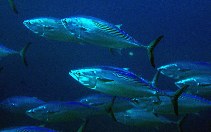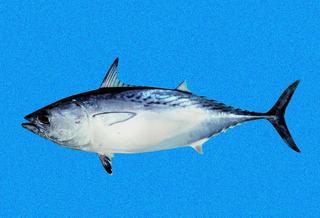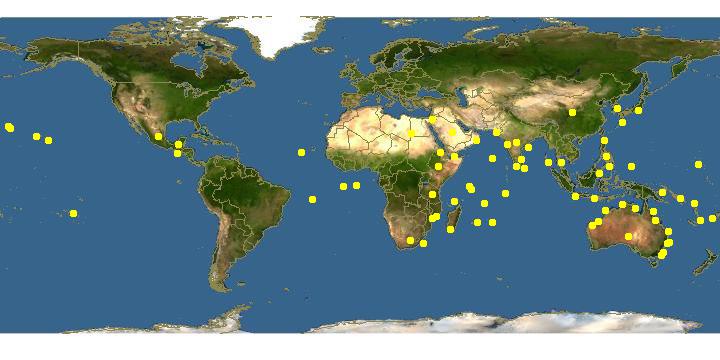|
| Links |
We parsed the following live from the Web into this page. Such content is managed by its original site and not cached on Discover Life. Please send feedback and corrections directly to the source. See original regarding copyrights and terms of use.
- Australian Faunal Directory
- FishBase
|
|
español |
|
|
Overview |
Main identification features
- lines on back: ~12 oblique
Kawakawa
Two small keels on tail base separated by a third, large keel; no adipose eyelids; jaw teeth slender, conical; corselet of large, thickened scales on front body, with body scaleless behind corselet; top of tongue with cartilaginous crests; pectorals 25-29 rays; ~9 dorsal finlets and ~7 anal finlets; small gap between 2 dorsal fins; first gill arch with 29-33 rakers.
Bluey above, silvery below; a cluster of black spots on belly above pelvic fin; ~12 oblique dark lines on upper back behind corselet.
Size: 110 cm; at least 13.2 kg.
Habitat: surface pelagic, coastal.
Depth: 0-50 m.
Indo-Pacific; vagrants in the Revillagigedos and southern Baja.
Attributes
Abundance: Common.
Cites: Not listed.
Climate Zone: Northern Tropical (Mexican Province to Nicaragua + Revillagigedos).
Depth Range Max: 50 m.
Depth Range Min: 0 m.
Diet: zooplankton; octopus/squid/cuttlefish; bony fishes; Pelagic crustacea.
Eastern Pacific Range: Northern limit=25; Southern limit=19; Western limit=-115; Eastern limit=-111; Latitudinal range=6; Longitudinal range=4.
Egg Type: Pelagic; Pelagic larva.
Feeding Group: Carnivore.
FishBase Habitat: Pelagic.
Global Endemism: All Pacific (West + Central + East); Indo-Pacific only (Indian + Pacific Oceans); TEP non-endemic; "Transpacific" (East + Central &/or West Pacific); All species.
Habitat: Water column.
Inshore Offshore: Offshore; Offshore Only.
IUCN Red List: Not evaluated / Listed.
Length Max: 110 cm.
Regional Endemism: Island (s) only; Island (s); Tropical Eastern Pacific (TEP) non-endemic; Eastern Pacific non-endemic; All species.
Residency: Vagrant.
Salinity: Marine; Marine Only.
Water Column Position: Mid Water; Near Surface; Surface; Water column only;
|
|
|
Names | |
|
|
|
Links to other sites | |
|
|
|
References |
- Cantor,., 1849., Catalogue of Malayan fishes., J. Asiatic Soc. Bengal, 18:981-1443.
- Collette , B. B. and Nauen, C. E., 1983., Scombrids of the world. An annotated and illustrated catalogue of tunas, mackerels, bonitos and related species known to date. FAO species catalogue Vol. 2., FAO Fish. Synop. No 125, 125.
- Collette, B.B., Reeb, C. and Block, B.A., 2001., Systematics of the tunas and mackerels (Scombridae)., Fish Physiology, 19:1-33.
- Eschmeyer , W. N. , Herald , E. S. and Hamman, H., 1983., A field guide to Pacific coast fishes of North America from the Gulf of Alaska to Baja California. Peterson Field Guide Ser. 28., Houghton Mifflin:336pp.
- Fischer , W. , Krup , F. , Schneider , W. , Sommer , C. , Carpenter , K. E. and Niem, V. H., 1995., Guia FAO para la Identificacion de Especies de para los fines de la Pesca. Pacifico Centro-Oriental. Volumen III. Vertebrados - Parte 2., FAO3:1201-1813.
- Galván-Magaña, F., Gutiérrez-Sánchez, F., Abitia-Cárdenas, L.A., Rodríguez-Romero, J., 2000., The distribution and affinities of the shore fishes of the Baja California Sur lagoons. In Aquatic Ecosystems of Mexico: Status and Scope. Eds. M. Manuwar, S.G. Lawrence, I.F. Manuwar & D.F. Malley. Ecovision World Monograph Series., Backhuys Publishers:383-398.
- Joseph , J. , Klawe , W. and Murphy, P., 1988., Tuna and Billfish - fish without a country., Inter-American Tropical Tuna Commission:69.
- Love, M.S., Mecklenburg, C.W., Mecklenburg, T.A., Thorsteinson, L.K., 2005., es of the West Coast and Alaska: a checklist of North Pacific and Artic Ocena species from Baja California to the Alaska-Yukon border., U.S. Department of the Interior, U.S. Geological Survey, Biological Resources Division, 288pp.
- Schaefer, K. M., 2001., Reproductive biology of tunas., Fish Physiology, 19:225-270.
|
|
|
Acknowledgements | |
I thank Ashley MacDonald and John Pickering, University of Georgia, for technical support in building this page.
|
|
| Supported by | |
|
Following modified from Australian Faunal Directory
|
Top | See original
| &pull 20q v5.145 20180528: Error 301 Moved Permanently http://biodiversity.org.au/afd/taxa/a24a29f3-a68b-49d0-a1c8-babfc0b2042b/ |
|
Following modified from FishBase
|
Top | See original
http://www.fishbase.org/Summary/speciesSummary.php?genusname=Euthynnus&speciesname=affinis ---> http://192.134.151.83/Summary/speciesSummary.php?genusname=Euthynnus&speciesname=affinis
http://192.134.151.83/Summary/speciesSummary.php?genusname=Euthynnus&speciesname=affinis ---> https://fishbase.mnhn.fr/Summary/speciesSummary.php?genusname=Euthynnus&speciesname=affinis
https://fishbase.mnhn.fr/Summary/speciesSummary.php?genusname=Euthynnus&speciesname=affinis ---> https://fishbase.mnhn.fr/summary/Euthynnus-affinis.html
Euthynnus affinis, Kawakawa : fisheries, gamefish

You can
sponsor
this page
Common name (e.g. trout)
Genus + Species (e.g. Gadus morhua)
-

-
About this page
-
Languages
-
User feedbacks
-
Citation
-
Uploads
-
Related species
-


 Kawakawa
Add your observation in
Fish Watcher
Upload your
photos
and
videos
Kawakawa
Add your observation in
Fish Watcher
Upload your
photos
and
videos
Pictures
|
Videos |
Google image
 Euthynnus affinis
Euthynnus affinis
Picture by
Field, R.
Teleostei (teleosts) >
Scombriformes
(Mackerels) >
Scombridae
(Mackerels, tunas, bonitos) > Scombrinae
Etymology:
Euthynnus:
Greek, eu = good + Greek, thynnos = tunna (Ref.
45335
)
.
Environment: milieu / climate zone / depth range / distribution range
Ecology
Marine; pelagic-neritic; oceanodromous (Ref.
51243
); depth range 0 - 200 m (Ref.
54439
). Tropical; 18°C - 29°C (Ref.
168
); 35°N - 38°S, 19°E - 137°W (Ref.
54439
)
Indo-West Pacific: in warm waters including oceanic islands and archipelagos. A few stray specimens have been collected in the Eastern Central Pacific. Highly migratory.
Length at first maturity / Size / Weight / Age
Maturity: L
m
42.3
, range 40 - 65 cm
Max length : 100.0 cm FL male/unsexed; (Ref.
168
); common length : 60.0 cm FL male/unsexed; (Ref.
168
); max. published weight: 14.0 kg (Ref.
30874
); max. reported age: 6 years (Ref.
121508
)
Dorsal
spines
(total): 10 - 15;
Dorsal
soft rays
(total): 11-15;
Anal
spines
: 0;
Anal
soft rays
: 11 - 15;
Vertebrae
: 39. This species is distinguished by the following characters: medium-sized fish with a robust, elongate and fusiform body; teeth small and conical, in a single series; total gill rakers on first gill arch 29-34; D1 XI-XIV with both dorsal fins separated by only a narrow interspace (not wider than eye), anterior spines of first fin much higher than those midway, giving fin a strongly concave outline; D2 much lower than first and followed by 8-10 finlets; anal fin followed by 6-8 finlets; pectoral fins short, never reaching interspace between dorsal fins; 2 flaps (interpelvic process) between pelvic fins; very slender caudal peduncle with a prominent lateral keel between 2 small keels at base of caudal fin; body naked except for corselet and lateral line. Colour of back dark blue with a complicated striped pattern which does not extend forward beyond middle of first dorsal fin; lower sides and belly silvery white; several characteristic dark spots between pelvic and pectoral fins (but may not always be present) (Ref.
9684
,
90102
).
Occurs in open waters but always remains close to the shoreline. The young may enter bays and harbors. Forms multi-species schools by size with other scombrid species comprising from 100 to over 5,000 individuals. A highly opportunistic predator feeding indiscriminately on small fishes, especially on clupeoids and atherinids; also on squids, crustaceans and zooplankton. Caught in multispecies fisheries, mainly by surface trolling; also with gill nets. Generally marketed canned and frozen; also utilized dried, salted, smoked and fresh (Ref.
9684
).
Collette, B.B. and C.E. Nauen
, 1983. FAO Species Catalogue. Vol. 2. Scombrids of the world. An annotated and illustrated catalogue of tunas, mackerels, bonitos and related species known to date. Rome: FAO. FAO Fish. Synop. 125(2):137 p. (Ref.
168
)
IUCN Red List Status (Ref.
130435
)
Least Concern (LC)
; Date assessed:
01 March 2022
CITES
Not Evaluated
Not Evaluated
Threat to humans
Reports of ciguatera poisoning (Ref.
30911
)
Human uses
Fisheries: highly commercial; gamefish: yes
FAO - Fisheries:
landings
,
species profile
; Publication:
search
| FIRMS -
Stock assessments
|
FishSource
|
Sea Around Us
More information
Countries
FAO areas
Ecosystems
Occurrences
Introductions
Stocks
Ecology
Diet
Food items
Food consumption
Ration
Common names
Synonyms
Metabolism
Predators
Ecotoxicology
Reproduction
Maturity
Spawning
Spawning aggregation
Fecundity
Eggs
Egg development
Age/Size
Growth
Length-weight
Length-length
Length-frequencies
Morphometrics
Morphology
Larvae
Larval dynamics
Recruitment
Abundance
BRUVS
References
Aquaculture
Aquaculture profile
Strains
Genetics
Electrophoreses
Heritability
Diseases
Processing
Nutrients
Mass conversion
Collaborators
Pictures
Stamps, Coins Misc.
Sounds
Ciguatera
Speed
Swim. type
Gill area
Otoliths
Brains
Vision
Tools
Bio-Quiz
|
E-book
|
Field guide
|
Identification keys
|
Length-frequency wizard
|
Life-history tool
|
Point map
|
Classification Tree
|
Catch-MSY
|
Special reports
Check for Aquarium maintenance
|
Check for Species Fact Sheets
|
Check for Aquaculture Fact Sheets
Download XML
Summary page
|
Point data
|
Common names
|
Photos
Internet sources
AFORO (otoliths)
|
Aquatic Commons
|
BHL
|
Cloffa
|
BOLDSystems
|
Websites from users
|
Check FishWatcher
|
CISTI
|
Catalog of Fishes
:
genus
,
species
|
DiscoverLife
|
ECOTOX
| FAO - Fisheries:
landings
,
species profile
; Publication:
search
|
Faunafri
| Fishipedia |
Fishtrace
| GenBank:
genome
,
nucleotide
|
GloBI
|
Google Books
|
Google Scholar
|
Google
|
IGFA World Record
|
MitoFish
|
National databases
|
Otolith Atlas of Taiwan Fishes
|
PubMed
| Reef Life Survey |
RFE Identification
|
Socotra Atlas
|
Tree of Life
| Wikipedia:
Go
,
Search
| World Records Freshwater Fishing |
Zoological Record
Estimates based on models
Preferred temperature (Ref.
123201
): 20.7 - 28.5, mean 26.9 °C (based on 1384 cells).
Phylogenetic diversity index (Ref.
82804
): PD
50
= 0.6250 [Uniqueness, from 0.5 = low to 2.0 = high].
Bayesian length-weight: a=0.01000 (0.00862 - 0.01160), b=3.05 (3.01 - 3.09), in cm total length, based on LWR estimates for this species (Ref.
93245
).
Trophic level (Ref.
69278
): 4.5 ±0.0 se; based on diet studies.
Generation time: 1.9 (1.2 - 2.5) years. Estimated as median ln(3)/K based on 10
growth studies.
Resilience (Ref.
120179
): Medium, minimum population doubling time 1.4 - 4.4 years (K=0.4-0.5; tm=3; Fec=210,000).
Prior r = 0.57, 95% CL = 0.37 - 0.85, Based on 3 stock assessments.
Fishing Vulnerability (Ref.
59153
): Moderate vulnerability (36 of 100).
Climate Vulnerability (Ref.
125649
): High to very high vulnerability (75 of 100).
Price category (Ref.
80766
):
Medium
.
Nutrients (Ref.
124155
): Calcium = 20.9 [9.6, 171.3] mg/100g; Iron = 2.28 [0.88, 5.97] mg/100g; Protein = 23.1 [21.1, 24.7] %; Omega3 = 0.235 [0.129, 0.428] g/100g; Selenium = 70.6 [35.4, 143.5] μg/100g; VitaminA = 20.2 [5.4, 77.8] μg/100g; Zinc = 0.408 [0.211, 1.643] mg/100g (wet weight); based on
nutrient studies.
Back to Search
Random Species
Back to Top
Accessed through:
Not available
FishBase mirror site :
localhost
Page last modified by :
mrius-barile
- 20 July 2016
Fatal error
: Uncaught ArgumentCountError: Too few arguments to function checkEcotox(), 1 passed in /var/www/html/summary/speciessummary.php on line 2304 and exactly 3 expected in /var/www/html/includes/speciessummary.lib.php:2579 Stack trace: #0 /var/www/html/summary/speciessummary.php(2304): checkEcotox() #1 {main} thrown in
/var/www/html/includes/speciessummary.lib.php
on line
2579
|
Updated: 2024-04-16 11:16:33 gmt
|







